Motor vehicle
| Peugeot 504 | |
|---|---|
 | |
| Overview | |
| Manufacturer | Peugeot SA |
| Also called | Guangzhou-Peugeot GP 7200 |
| Production | |
| Assembly |
|
| Designer | Aldo Brovarone at Pininfarina |
| Body and chassis | |
| Class | Large family car (D) |
| Body style | 4-door saloon 5-door estate 2-door coupé 2-door convertible 2-door coupé utility (pickup) 4-door coupé utility (pickup) |
| Layout | FR layout |
| Powertrain | |
| Engine | |
| Transmission | 4-speed manual BA7 5-speed manual 3-speed automatic ZF 3HP12/22 3-speed automatic GM 407 (V6) |
| Dimensions | |
| Wheelbase | 2,740 mm (107.9 in) (saloon/berline) 2,900 mm (114.2 in) (break/pickup) 2,550 mm (100.4 in) (coupé/cabriolet) |
| Length | 4,486 mm (176.6 in) (saloon/berline) 4,800 mm (189.0 in) (break) |
| Width | 1,690 mm (66.5 in) |
| Height | 1,460 mm (57.5 in) |
| Curb weight | 1,200–1,300 kg (2,646–2,866 lb) |
| Chronology | |
| Predecessor | Peugeot 404 |
| Successor | Peugeot 505 Peugeot 406 Coupé (for 504 Coupé) |
The Peugeot 504 is a mid-size, front-engine, rear-wheel-drive automobile manufactured and marketed by Peugeot from 1968 to 1983 over a single generation, primarily in four-door sedan and wagon configurations – but also as twin two-door coupé and cabriolet configurations as well as pickup truck variants.
The sedan (berline) was styled by Aldo Brovarone of Pininfarina, and the coupé and cabriolet twins were styled by Franco Martinengo at Pininfarina, with wagon (break and familiale) and pickup (camionette) designed and sketches produced in-house at Peugeot.
The 504 was noted for its robust body structure, long suspension travel, high ground clearance, large wheels and torque tube driveshaft – enclosed in a rigid tube attached at each end to the gearbox housing and differential casing, relieving drivetrain torque reactions. The 504 ultimately achieved widespread popularity in far-flung rough-terrain countries – including Latin America and much of Africa.
More than three million 504s were manufactured in its European production, with production continuing globally under various licensing arrangements – including 27,000 assembled in Kenya and 425,000 assembled in Nigeria, using knock-down kits – with production extending into 2006.
Having debuted as Peugeot's flagship at the 1968 Paris Salon, the 504 received the 1969 European Car of the Year. In 2013, the Los Angeles Times called it "Africa's workhorse."
History
Introduction
Marketed as Peugeot's flagship saloon car, the 504 made its public debut on 12 September 1968 at the Paris Salon. The press launch which had been scheduled for June 1968 was at the last minute deferred by three months, and production got off to a similarly delayed start because of the political and industrial disruption which exploded across France in May 1968.
The 504 was a sunroof-equipped four-door saloon, introduced with a carbureted 1,796 cc four-cylinder petrol engine 60 kW (82 PS; 81 hp) DIN with 71 kW (97 PS; 96 hp) on tap with the optional fuel injection. At the time of introduction, Peugeot still used the SAE rating, with claimed power numbers of 87 and 103 cv respectively. A column-mounted four-speed manual transmission was standard; a three-speed ZF 3HP12 automatic became available with the carburetted engine beginning in February 1969. In September 1969 the automatic's shifter location was moved from the steering column to the floor.
The 504 was elected European Car of the Year in 1969, praised for its styling, quality, chassis, ride, visibility, strong engine and refinement. 1969 was also when the 504 reached the Australian market.
The 504 Injection two-door coupé and two-door cabriolet were introduced at the Salon de Geneva in March 1969. The engine produced the same 71 kW (97 PS; 96 hp) of output as in the fuel-injected saloon, but the final drive ratio was slightly revised to give a slightly higher road speed of 20.6 mph (33.2 km/h) at 1,000 rpm. Unlike the saloons, the coupé and cabriolet received a floor shifter.
Available models:
- 504 4-door saloon
- 504 Injection 4-door saloon
- 504 Injection 2-door coupé
- 504 Injection 2-door cabriolet
1970
The 504 received a new four-cylinder 1971 cc engine, rated at 68 kW (93 PS; 92 hp) (carburated) and 76 kW (104 PS; 103 hp) (fuel-injected). At the 1970 Paris Salon a four-cylinder 2112 cc diesel engine rated at 48 kW (65 PS; 64 hp) was introduced. The 1796 cc petrol engine was no longer available in 504 saloons.
In September 1970 an estate ("Break") was presented, featuring a higher rear roof, lengthened wheelbase, and solid rear axle with four coil springs. It was joined by the 7-seat "Familiale", which had all its occupants facing forward in three rows of seats. The Break/Familiale/Commerciale did not actually go on sale until April the following year. The Break and Familiale both received the 2-liter petrol engine or 2.1 diesel as per the saloon, but the utilitarian "Commerciale" brought back the 1.8-litre four, now tuned down to 54 kW (73 PS; 72 hp). There was also a Commerciale diesel, using the 39 kW (53 PS; 52 hp), 1.95-liter XD88 from the 404 Diesel, enough for a top speed of 118 km/h (73 mph). The Commerciale had a stripped down interior, with a different dashboard, no carpeting in the cargo area, and seats without headrests. It also received lightly reinforced suspension, single round headlights (seen again on pickups from 1979 on), missing chrome around the side windows, and some trim parts such as the rear view mirrors were painted rather than chromed.
In late 1970 an automatic option was added to the coupé and cabriolet - this was never a large seller and was not always available to the cabriolet but continued to be offered until 1983; in total about 2,500 of the two-door 504s received this transmission option.
- Models
- 504 Commerciale 5-door utility wagon
- 504 4-door saloon/5-door Break/Familiale
- 504 Injection 4-door saloon
- 504 Commerciale Diesel 5-door utility wagon
- 504 Diesel 4-door saloon/5-door Familiale
- 504 Injection 2-door coupé
- 504 Injection 2-door cabriolet
1971
During 1971 the Break SL ("Super Luxe") was introduced, a better equipped version using the carburetted 2.0-liter engine. Unlike the regular wagons, the SL received metallic paint, plusher upholstery, and various other additional equipment.
1972
During the year, fuel injected 504 saloons changed to a floor-mounted shifter on cars equipped with the manual transmission as well. The 504 Commerciale dropped the round headlights in favor of the standard units.
1973
In April 1973, because of the oil crisis Peugeot presented the 504 L. It featured a coil sprung live rear axle and reintroduced the smaller 1796 cc engine, now rated at 58 kW (79 PS; 78 hp) or 60 kW (81 PS; 80 hp) for the L Automatique. The different rear axle required somewhat more space; this required some alterations to the floor pan which meant marginally less boot space and rear headroom. At around the same time, the lineup was revamped as listed below. Also new was the 1.95-litre 504 LD saloon, matching the Commerciale diesel although producing 41 kW (56 PS; 55 hp). The power of the Commerciale diesel dropped to 37 kW (50 PS; 49 hp) at the same time. The L saloons can be recognized by the missing bumper overriders and inside by the simpler dashboard with horizontal instrument cluster. Also during 1973, the column shifters were replaced by floor mounted ones on all other 504 saloons than the L.
- Models
- 504 L saloon (1.8 carb)
- 504 GL saloon (2.0 carb)
- 504 TI saloon (2.0 injection)
- 504 LD saloon (1.95 diesel)
- 504 GLD saloon (2.1 diesel)
- 504 Commerciale (1.8 carb)
- 504 Break/Break SL/Familiale (2.0 carb)
- 504 Commerciale Diesel (1.95 diesel)
- 504 Familiale Diesel (2.1 diesel)
- 504 Coupé (2.0 injection)
- 504 Cabriolet (2.0 injection)
1974
In August 1974 the second series 504 was introduced. The most noticeable change was the new, more flush fitting doorhandles, and new wheels with rectangular rather than oval openings on the GL and TI models. The GL and TI also received a new, more padded steering wheel. Additionally, the 2.0's double carburettor was changed from the Solex SEIA to a Zenith INAT (with no change in power), while the liftgate on the estates changed from steel springs to gas struts.
At the 1974 October Motor Show Peugeot presented a more powerful engine for the 504 coupé and cabriolet, now fitted with a "PRV" 2664 cc V6 unit developed in collaboration with Renault and Volvo. This was the same engine that would be used for the 604 berline, to be introduced at Geneva five months later, in March 1975. The engine incorporated various innovative features such as an aluminium cylinder block, and a fuel-feed system that employed carburetors of differing type, one (type 34 TBIA) featuring a single chamber controlled directly according to the movement of the accelerator pedal, and the second being a twin chamber carburetor (type 35 CEEI) designed to operate simultaneously with the first, using a pneumatic linkage. Maximum output for the 504 coupé and cabriolet fitted with this new V6 engine was given as 100 kW (136 PS; 134 hp), supporting a top speed of 186 km/h (116 mph). During 1975, the first full year of production, 2643 of these six-cylinder 504 coupés and cabriolet were produced, which was considered a respectable number although dwarfed by the 236,733 four-cylinder 504 berlines (saloons/sedans) and breaks (estates/station wagons) produced by Peugeot in France in the same year. Following the launch of the six-cylinder cars, the four-cylinder versions of the coupé and cabriolet 504s were delisted: they returned to the showrooms in 1978 in response, it was reported, to customer demand.
1975
The Break and Break SL were renamed L and GL. The 504 TI received power windows in the rear as well.
1976
At the Paris Motor Show of October 1976 an enlarged diesel engine was introduced for the 504 GLD saloon. The stroke of 83 mm (3.3 in) remained the same as that of the existing 2112 cc diesel motor, but for the larger engine the bore was increased to 94 mm (3.7 in), giving an overall 2304 cc along with an increase in claimed power output from 48 to 51 kW (65 to 70 PS; 64 to 69 hp). Briefly, the 2.1 diesel was not offered on any 504 saloons. The 2112 cc diesel engine would also find its way into the Ford Granada since Ford did not at the time produce a sufficient volume of diesel sedans in this class to justify the development of their own diesel engine. From August 1976 on, the power of the 2-liter petrol engines increased marginally, to 71 and 78 kW (96 and 106 PS; 95 and 105 hp) for the carburetted and fuel injected engines respectively. The grille on the 504 L models was changed from the original chromed metal piece to a black, plastic unit. The 504 TI gained power steering.
1977
In September 1977, the 2.3-liter diesel found its way into the new GLD Break and the Familiale Diesel, while the Break L now received a downtuned version of the old 2.1-liter unit, producing 43 kW (59 PS; 58 hp). Also new was the option of an automatic transmission for the 2.3 diesel (saloons only). The old 1.9-liter diesel was discontinued, and the basic 504 saloons dropped the "L" designation, gaining a black plastic dash and the steering wheel from the GL/TI in the process. The new 504 diesel saloon was fitted with the erstwhile, 48 kW (65 PS; 64 hp) 2.1-liter diesel engine that had graced the GLD until the introduction of the 2.3.
The coupé and cabriolet saw the reintroduction of the fuel injected 2.0-liter engine, a response to slow sales of the thirsty V6. The V6 coupé gained a five-speed manual transmission and fuel injection for 106 kW (144 PS; 142 hp), while the V6 cabriolet was discontinued after only 970 examples had been built in three years.
1979 to 1983
Peugeot 504 production in Europe was pruned back in 1979 with the launch of the Peugeot 505, although the 504 Pickup was introduced as a replacement for the 404 Pickup for the 1980 model year. The last European-made example rolled off the production line in 1983, although the pick up version continued in production, and was available in Europe until 1993. More than three million 504 passenger cars were produced in Europe. The 505 shared most of the Peugeot 504 mechanical parts, similarly to the Peugeot 604 and Talbot Tagora.
-
 Saloon
Saloon
-
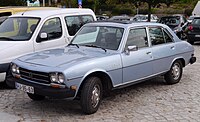 US-market Saloon with bigger bumpers, sealed-beam headlamps, and side marker lights
US-market Saloon with bigger bumpers, sealed-beam headlamps, and side marker lights
-
 Saloon interior
Saloon interior
-
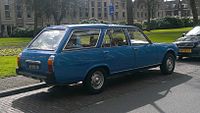 Break
Break
-
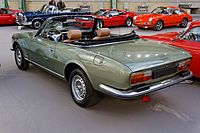 Cabriolet
Cabriolet
-
 Coupé
Coupé
-
Coupé
-
 Pickup
Pickup
Markets
As of December 2015, 197 examples of the Peugeot 504 are still in use in Britain.

- United States
For several years, the 504 was Peugeot's only model offered in North America. Originally very similar to European specified models, the 504 had to be gradually modified to meet the federal emissions and safety standards. The 2-litre petrol engine was offered alongside the 2.1 diesel, later replaced by the 2.3.
In 1974, the US-spec carburetted 2-litre engine produced 82 hp (61 kW; 83 PS) at 5200 rpm with a low 7.6:1 compression ratio. The 2.1 diesel was unchanged vis-à-vis the global model, producing 62 hp (46 kW; 63 PS) at 4500 rpm.
Post-European production
Africa
Manufacturing continued in Kenya until 2004, and Nigeria until 2006, using the Peugeot knock down kits, which meant that versions of the 504 had been in production in various parts of the world for a total of 38 years. Kenyan production was 27,000 units and the car remained on sale to 2007, being described as "King of the African road". Egypt also had its own production facilities. In South Africa it was built by PACSA (Peugeot and Citroën South Africa) alongside the 404 until late 1978. Sigma Motor Corporation took over from PACSA in early 1979 and moved 504 production to their "Sigma Park" plant east of Pretoria. South Africa received the two-liter and TI versions until mid-1976 when the lower priced 1800 L version was added. The L has a matt black grille and window surrounds, and did not receive bumper overriders. A similarly equipped L Wagon had arrived earlier in the year, to replace the discontinued 404 Wagon. The Peugeot 504 is also one of the most common vehicles employed as a bush taxi in Africa.
Asia-Pacific

The car was assembled in various countries, under license of Peugeot. In Australia it was first released in 1969 and was assembled by Peugeot's rival Renault, and sold through Renault Australia's dealer network. In 1981 the 504 GL retailed for AUD $11,000. Only the saloon was assembled in Australia, while the Break and Familiale models were imported fully built-up from France.
In China, the 504 was produced in pickup form, with a four-door crew cab, a live rear axle, on an extended estate platform. These were built by Guangzhou Peugeot Automobile Company. Chinese production of the 504 pickup ceased in 1997, when the joint venture folded.
South America
 Redesigned Argentinian version of the 504 (1993-1999).
Redesigned Argentinian version of the 504 (1993-1999). 1995 Peugeot 504 SX 2.3 (rear view).
1995 Peugeot 504 SX 2.3 (rear view).
The Peugeot 504 was also produced by SAFRAR in Argentina, beginning in 1969. In 1980 Sevel Argentina took over production in El Palomar near Buenos Aires, in sedan, estate (1980 and 1981 only), and pickup forms. The sedan was built until 1999, with the last new cars sold in 2000. The pickup was manufactured in single and double cab with payload of over 1 tonne (1300 kg ) from 1983 to 1997, and exported mainly to bordering countries. In 1991 the later models were restyled at the front and rear, with the lamps and bumpers changing design. These cars were also given a new interior. Argentinian 504s offered the 1971 cc petrol four-cylinder or the 2304 cc diesel.
SAFRAR also produced a sports version of the sedan called 504 TN between 1977 and 1978; this was intended to suit local competition classes like Turismo Nacional hence the name of the version. This version had a XN1 2.0 litres engine but with a new intake and exhaust manifold with four individual outlets, a double-mouth Solex carburetor and a camshaft with greater elevation (7.5 mm against 6.7 mm of the previous one) among other changes with the engine reaching 81 kW (110 PS; 108 hp).
Dangel models
The French company Dangel also produced Peugeot approved four-wheel drive Break (estate/station wagon) and pickup models.
Its engines and suspension were used in later models of the Paykan, the Iranian version of the Hillman Hunter.
Pickup and commercials
In September 1979, for the 1980 model year, the 504 Pickup was introduced. The considerable work involved in converting the 504's monocoque body into a load-carrying version had taken a full decade. The pickup used the longer wheelbase and live rear axle of the 504 Break. On introduction, it was available with very basic spec and single round headlights, fitted in plastic frames shaped like the 504's "cat's eyes." The engine options were the 404's 1618 cc petrol (U01) and 1948 cc diesel (U20); outputs are 62 and 49 PS (46 and 36 kW) respectively. This was the only 504 sold with the 1.6-litre XC5 engine. As with most of Peugeot's commercial vehicles, the 504 Pickup was assembled by Chausson. Cargo capacity was 1,100 kg (2,400 lb) for both versions; models exported to Africa were rated at 1,250 kg (2,760 lb) (V01/V20). A chassis cab model was also offered, and manufacturers such as Heuliez offered a number of different applications for the 504 chassis. Germany's Bimobil even offered a demountable camper for the 504, weighing about 450 kg (990 lb). Around 300 of these were built, following an initial order of twenty made by Peugeot themselves.
As with the regular 504, the pickup has rear-wheel-drive and a floor-shifted four-speed manual transmission. A locking differential was also standard. Late-model pickups were also available with a five-speed transmission. In July 1981, Dangel added a four-wheel-drive version of the Pickup. These were mainly purchased by French governmental agencies, as their procurement rules required them to purchase French when possible. About 5500 Dangel 4x4 Pickups were built until the model's discontinuation in 1994.
For 1982 the better equipped 504 Pickup GR was added, these received some chrome touches and luxuries such as a clock and door-mounted armrests. Externally, the GR was set apart by black rubber bumper overriders, different hubcaps and a modicum of chrome ornamentation (the standard version received a grille and bumpers painted light gray). By 1984, the chrome parts were dropped in favor of a cleaner, more modern appearance. The GR was renamed "Confort" in 1987, at least in the French domestic market. This is also when the 1.6 petrol option was discontinued. The GR received an 80 PS (59 kW) version of the 504's 1.8-liter petrol engine, while the GRD had the 70 PS (51 kW) 2.3-liter diesel. The French models were then renamed "Entrepreneur" in 1988 (by now with a 2.1 Diesel) and was upgraded to the 2.3-liter diesel for 1990. Trim levels received differing names in various markets; in Britain, most later 504 Pickups received "GL" badging. For 1995 and 1996, subsequent to the end of pickup production in France, Argentinian 504 Pickups were exported to France. These can be recognized by the large modernized front bumper and redesigned dashboard.
-
 The 504 Pickup Commerciale front, with single round headlights
The 504 Pickup Commerciale front, with single round headlights
-
 Dangel Peugeot 504 4x4 Pickup belonging to the French forest fire service
Dangel Peugeot 504 4x4 Pickup belonging to the French forest fire service
-
 A 504 Pickup used as popemobile
A 504 Pickup used as popemobile
-
 Argentinian-built 504 Double-Cab Pickup
Argentinian-built 504 Double-Cab Pickup
-
 The 504 Ambulance used the same heavy-duty rear suspension as the pickup versions
The 504 Ambulance used the same heavy-duty rear suspension as the pickup versions
-
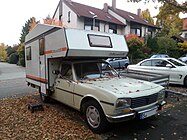 A Peugeot 504 Pickup-based RV
A Peugeot 504 Pickup-based RV
-
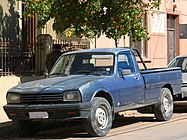 Chilean 504 Single-Cab Pickup.
Chilean 504 Single-Cab Pickup.
Mechanical configuration
The car was rear-wheel drive, with longitudinally mounted engines, canted over to bring a lower bonnet line to the styling. Manual and automatic transmissions were offered. The suspension system consisted of MacPherson struts at the front and mainly coil springs at the rear. Sedan, coupé, and cabriolet models additionally had rear semi-trailing arms whereas wagons and pickups had a simpler live rear axle with coils or heavy-duty leaf springs respectively. Most 504 models used a torque tube driveline. With long suspension travel and great strength, the 504 was suited to rough road conditions, and the car proved extremely reliable in conditions found in Africa, Asia, Australia and the like.
The car used disc brakes at the front, and either disc brakes or drum brakes at the rear, depending on the model. Brake pad wear warning via an instrument panel indicator light was a notable innovation. The steering was a rack and pinion system. The Peugeot 504 was widely available with diesel engines and an automatic transmission option, which was a rare combination at the time. Engines were of the Indenor [fr] design and included 1948 cc, 2112 cc, and a 2304 cc. The Indenor engine was also used in dozens of other automobiles and light commercials as well as for marine applications.
There were three petrol engines available in Europe, 1796 cc and 1971 cc four cylinder and a 2664 cc V6. The two-litre engine was also available with Kugelfischer mechanical fuel injection, first available on the earlier Peugeot 404. Gearboxes were either the BA7, four-speed manual or ZF three-speed automatic. Later pickup trucks in Europe gained a fifth gear. Export market vehicles had different variations available.
Politics
In 1976, the Government of Sri Lanka purchased a large number of Peugeot 504s for use of dignitaries attending the Fifth Non-Aligned Movement summit in Colombo.
In November 2010. Iranian state television announced Iranian President Mahmoud Ahmadinejad was to auction off his 1977 Peugeot 504 to raise money for charity. The car is white with a sky-blue interior, and has covered only 37,000 km since new. The political significance of the car being a 504 is that it was used as a working-class status symbol to draw electoral support from the less well-off during the 2005 presidential campaign. The money earned from the sale at international auction is to be donated to the Mehr housing project, a network of cooperatives that provides affordable housing for low-income families. Soon after being put on auction in January 2011, a bid of $1 million was received from "an Arab country". When the auction closed in March 2011, the final bid was $2.5 million.
Motorsport

Peugeot 504s won the following World Rally Championship events:
Event Season Driver Co-driver Car  23rd Safari Rally
23rd Safari Rally
1975  Ove Andersson
Ove Andersson
 Arne Hertz
Arne Hertz
Peugeot 504  18ème Rallye du Maroc
18ème Rallye du Maroc
1975  Hannu Mikkola
Hannu Mikkola
 Jean Todt
Jean Todt
Peugeot 504  19ème Rallye du Maroc
19ème Rallye du Maroc
1976  Jean-Pierre Nicolas
Jean-Pierre Nicolas
 Michel Gamet
Michel Gamet
Peugeot 504  26th Safari Rally
26th Safari Rally
1978  Jean-Pierre Nicolas
Jean-Pierre Nicolas
 Jean-Claude Lefèbvre
Jean-Claude Lefèbvre
Peugeot 504 V6 Coupé  10ème Rallye Bandama Côte d'Ivoire
10ème Rallye Bandama Côte d'Ivoire
1978  Jean-Pierre Nicolas
Jean-Pierre Nicolas
 Michel Gamet
Michel Gamet
Peugeot 504 V6 Coupé
References
- ^ Boyce, David, ed. (1981), What car is that? : in Australia & New Zealand, Adelaide, Australia: Rigby, p. 133, ISBN 0727014803
- "Dossier le secteur automobile marocain" (PDF). Al Wassit Magazine (in French). May–June 1998.
- ^ Howard, Tony, ed. (June 1979). "From the Marketplace". SA Auto. 1 (10). Pretoria, South Africa: 21.
- "Vehículos del Centro". Archived from the original on 4 March 2015. Retrieved 27 May 2015.
- Banque Centrale de Tunisie, 25ème Rapport d'activité. Exercice 1983.
- Fernández Fenocchi, Eduardo; Piñeiro Da Rosa, Matías; Sorrentino Fenocchi, Gastón (March 2012). "Aplicación del Cuadro de Mando Integral en Nordex S.A." [Application of the Balanced Scorecard at Nordex S.A.] (PDF) (in Spanish). Montevideo, Uruguay: Universidad de la República: Facultad de Ciencias Económicas y de Administración. pp. 50–51. Archived from the original (PDF) on 20 November 2016.
- "Aldo Brovarone". Archived from the original on 19 March 2012. Retrieved 13 February 2012.
- ^ Sjöholm, Gustaf (6 November 2004). "Where Forty-Year Old Peugeots Are Still Hot Stuff". Petrolicious.
- Ini Okon Utuk (10 February 2013). "Our heritage, our tradition, our Peugeot 504". Daily Trust.
- "Grand Foundry & Engineering Works Limited". grandfoundry. Archived from the original on 18 July 2007. Retrieved 9 September 2007.
- Hiltzik, Michael (4 December 2013). "Is the Peugeot 504 reaching its end as Africa's workhorse?". LA Times.
- Frère, Paul (7 September 1968). "Continental Diary". The Motor (3455): 37.
- Allain, François (1996). Guide Peugeot: Tous le modèles de 1970 à 1990 (in French). E/P/A. p. 14. ISBN 2-85120-493-9.
- Allain, p. 15
- ^ "New Models at Geneva: Open and closed 504s". Autocar. 130 (3812): 30–31. 6 March 1969.
- ^ Allain, pp. 22-23
- ^ Allain, pp. 18-19
- ^ Peugeot 504 Break et Commerciale (brochure) (in French), Peugeot S.A., October 1972, p. 16, archived from the original on 30 July 2022
- ^ "The evolution of PEUGEOTs world car in Europe 1968 - 1983". Garage 24. Rainer Wilken. Archived from the original on 16 December 2021.
- ^ Howard, Tony (October 1976). "Peugeot's 'Economy' 504". SA Motor. Cape Town, South Africa: Scott Publications: 22.
- de Jong, Sicco (27 April 1973). "Eenvoudiger versie van Peugeot 504 (Simpler version of Peugeot 504)". Trouw. Amsterdam, the Netherlands: BV De Christelijke Pers: T13.
- ^ Bellu, René (2005). "Toutes les Voitures Françaises 1975 (Salon Paris October 1974)". Automobilia (Spécial 72). Paris: Histoire & Collections: 39, 44–45.
- Allain, p. 41
- "Peugeot's bigger diesel". Autocar. 146 (4192): 24–25. 12 March 1977.
- Allain, p. 53
- "100 popular cars vanishing from our roads". MSN UK. MSN. Retrieved 15 June 2016.
- Wakefield, Ron, ed. (January 1974). "R&T Specifications 1974". Road & Track. Vol. 25, no. 5. CBS Consumer Publishing Division. p. 98.
- "Peugeot Kenya". Peugeot. Archived from the original on 8 October 2007. Retrieved 16 January 2013.
- Boyce, p. 134
- ^ de Feijter, Tycho (23 January 2012). "Spotted in China: Peugeot 504 pickup in a Sorry State". CarNewsChina.com.
- ^ Álvarez, Francisco (18 May 2009). "Peugeot 504". Coche Argentino (in Spanish). Archived from the original on 13 June 2020.
- ^ Quattroruote: Tutte le Auto del Mondo 1992 (in Italian). Milano: Editoriale Domus. 1992. pp. 790–791.
- ^ "Así probábamos al Peugeot 504 TN" [Here we test the Peugeot 504 TN]. Parabrisas (in Spanish). 2 August 2020.
- ^ "Peugeot 504 Pick-Up (1980-2005)" (in French). 6 November 2016.
- Wacker, Heiko P. (20 September 2017). "Der Bimobil-Oldie der Gründer: Abnehmbare Wohnkabine auf Peugeot 504" [The founder's Bimobil-oldie: Dismountable camper on a Peugeot 504]. ProMobil. No. 10. Stuttgart, Germany: Motor Presse Stuttgart.
- Meurer, Stany (28 April 1983). "Dossier Pick-up" [The pickup file]. De AutoGids (in Flemish). 4 (94). Brussels, Belgium: Uitgeverij Auto-Magazine: 46.
- ^ Meurer, p. 44
- Sirimanna, Bandula (26 May 2013). "Govt. slashing CHOGM cost, limousines to be hired". The Sunday Times. Colombo, Sri Lanka.
- "Mahmoud Ahmadinejad's car auction gets '$1m bid'". BBC News Online. 2 January 2011. Retrieved 29 August 2011.
- "Ahmadinejad's Creaking Peugeot 504 to Fetch $1M?". Luxury Insider Magazine. 3 January 2011. Retrieved 3 December 2011.
- Cohen, Dudi (22 October 2010). "Wanna buy a car from Ahmadinejad?". Ynetnews. ynetnews.com (Israel). Retrieved 3 December 2011.
- "Ahmadinejad to auction 1977 Peugeot 504 - RTÉ News". Rte.ie. 22 November 2010. Retrieved 21 December 2010.
- "Official Website for Registration of Charity Auction of Islamic republic of Iran President's car". Iran Government. 19 January 2011. Archived from the original on 19 January 2011. Retrieved 3 December 2011.
- "Ahmadinejad's Peugeot 504 car sells for $2.5m". Botswana Telegraph. 3 March 2011. Archived from the original on 31 March 2012. Retrieved 29 August 2011.
External links
| Peugeot vehicles | ||||||||||
|---|---|---|---|---|---|---|---|---|---|---|
| A brand of Stellantis | ||||||||||
| Current vehicles |
| |||||||||
| Historic vehicles |
| |||||||||
| Motorsport | ||||||||||
| Concept cars | ||||||||||
| Related topics | ||||||||||
| « previous — Peugeot road vehicle timeline, 1940–1979 — next » | ||||||||||||||||||||||||||||||||||||||||||||||||||||||||||||||||||||||||||||||||||||||||||||||||||||||||||||||||||||||||||||||||||||||||||||||||||||||||||||||||||||||||||||||||||||||||||||||||||||||||||||||||||||||||||||||||||||||||||||||||||||||||||||||||||||||||||||||||||||||||||||||||||||||||||||||||||||||||||||||||||||||||||||||||||||||||||||||||||||||||||||||||||||||||||||||||||||||||||||||||||||||||||||||||||||||||||||||||||||||||||||||||
|---|---|---|---|---|---|---|---|---|---|---|---|---|---|---|---|---|---|---|---|---|---|---|---|---|---|---|---|---|---|---|---|---|---|---|---|---|---|---|---|---|---|---|---|---|---|---|---|---|---|---|---|---|---|---|---|---|---|---|---|---|---|---|---|---|---|---|---|---|---|---|---|---|---|---|---|---|---|---|---|---|---|---|---|---|---|---|---|---|---|---|---|---|---|---|---|---|---|---|---|---|---|---|---|---|---|---|---|---|---|---|---|---|---|---|---|---|---|---|---|---|---|---|---|---|---|---|---|---|---|---|---|---|---|---|---|---|---|---|---|---|---|---|---|---|---|---|---|---|---|---|---|---|---|---|---|---|---|---|---|---|---|---|---|---|---|---|---|---|---|---|---|---|---|---|---|---|---|---|---|---|---|---|---|---|---|---|---|---|---|---|---|---|---|---|---|---|---|---|---|---|---|---|---|---|---|---|---|---|---|---|---|---|---|---|---|---|---|---|---|---|---|---|---|---|---|---|---|---|---|---|---|---|---|---|---|---|---|---|---|---|---|---|---|---|---|---|---|---|---|---|---|---|---|---|---|---|---|---|---|---|---|---|---|---|---|---|---|---|---|---|---|---|---|---|---|---|---|---|---|---|---|---|---|---|---|---|---|---|---|---|---|---|---|---|---|---|---|---|---|---|---|---|---|---|---|---|---|---|---|---|---|---|---|---|---|---|---|---|---|---|---|---|---|---|---|---|---|---|---|---|---|---|---|---|---|---|---|---|---|---|---|---|---|---|---|---|---|---|---|---|---|---|---|---|---|---|---|---|---|---|---|---|---|---|---|---|---|---|---|---|---|---|---|---|---|---|---|---|---|---|---|---|---|---|---|---|---|---|---|---|---|---|---|---|---|---|---|---|---|---|---|---|---|---|---|---|---|---|---|---|---|---|---|---|---|---|---|---|---|---|---|---|---|---|---|---|---|---|---|---|---|---|---|---|---|---|---|---|---|---|---|---|---|---|---|---|---|---|
| ||||||||||||||||||||||||||||||||||||||||||||||||||||||||||||||||||||||||||||||||||||||||||||||||||||||||||||||||||||||||||||||||||||||||||||||||||||||||||||||||||||||||||||||||||||||||||||||||||||||||||||||||||||||||||||||||||||||||||||||||||||||||||||||||||||||||||||||||||||||||||||||||||||||||||||||||||||||||||||||||||||||||||||||||||||||||||||||||||||||||||||||||||||||||||||||||||||||||||||||||||||||||||||||||||||||||||||||||||||||||||||||||